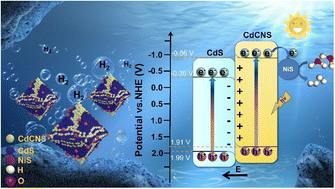Surface-active site modulation of the S-scheme heterojunction toward exceptional photocatalytic performance†
Abstract
Heterojunction photocatalysts have shown their immense capability in enhancing photogenerated charge carrier separation. Yet, the intrinsic scarcity of active sites in semiconductor components of heterojunction photocatalysts limits their potential for photocatalysis being used in practical applications. Herein, we employ a non-noble metal cocatalyst (i.e., NiS) for modulating a S-scheme heterojunction photocatalyst consisting of Cd3(C3N3S3)2 (CdCNS) and CdS. It is revealed that the formation of the CdCNS/CdS S-scheme heterojunction can enable optimal photogenerated charge carrier utilization efficiency and optimized redox capability. More importantly, the meticulous loading of NiS can play multiple roles in enhancing the photocatalytic performance of the CdCNS/CdS photocatalyst, including endowing it with abundant surface-active sites and acting as a photogenerated electron acceptor. As a result, the optimized NiS-loaded CdCNS/CdS attains an excellent hydrogen production rate of 38.17 mmol g−1 h−1, to reach a quantum efficiency of 29.02% at 420 nm. The results reported in this work provide an interesting insight into the important roles of surface-active site modulation in optimizing photocatalytic performances.

- This article is part of the themed collection: Nanoscale 2023 Emerging Investigators


 Please wait while we load your content...
Please wait while we load your content...